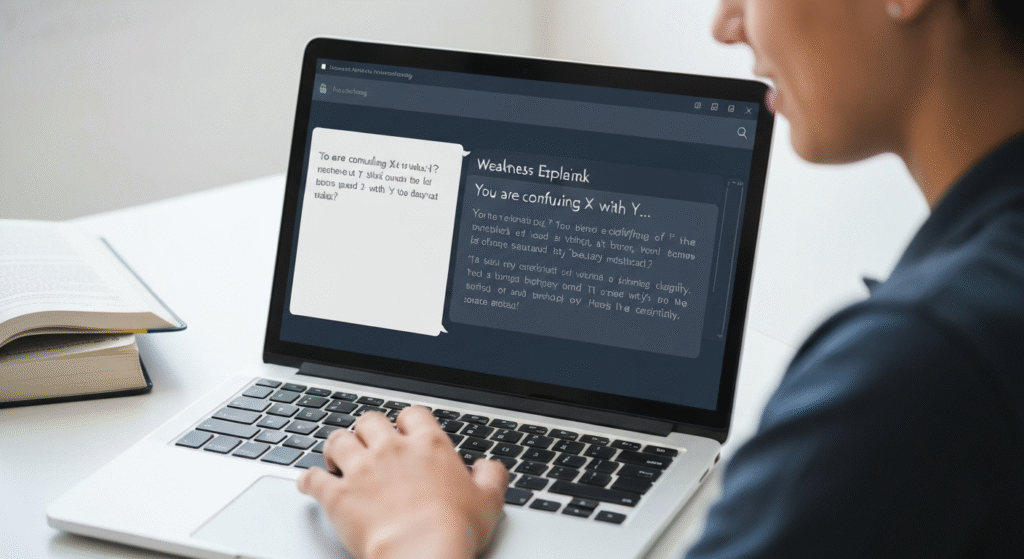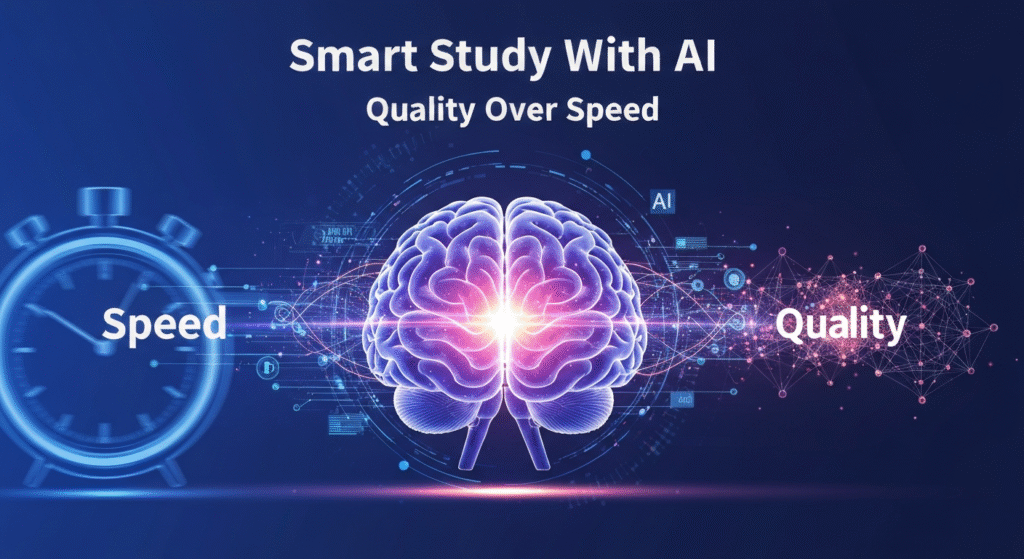Everyone wants the quick fix. The internet is flooded with “AI study hacks” that promise to summarize a 100-page textbook in 30 seconds or write an A+ essay while you sleep. I get the appeal. But after years of trying to find better ways to learn, I’ve found a hard truth: faster isn’t better. In fact, most of these “hacks” are just a fast-track to forgetting.
The real power of AI in education isn’t as a summary machine. It’s as a personal, 24/7 study partner. It’s a tool that can help you achieve deep, meaningful learning—the kind that actually sticks. But you have to use it right. This isn’t about speed; it’s about quality. I’m going to share the exact, sustainable study system I developed, what worked, what failed, and how I finally started learning smarter, not just faster.
Before we dive into the method, let me quickly introduce myself. I’m John Michael. For the past five years, I’ve been fascinated with how AI can genuinely help us learn, not just work faster. I’ve spent countless hours testing different methods, trying to separate the hype from what actually works for long-term knowledge. My goal isn’t to find shortcuts, but to build a better brain with new tools. I’m here to share the research, context, and clear explanations I’ve gathered along the way.
Why “Speed-Studying” With AI Is a Trap

When I first started using AI for my studies, I made the same mistake everyone else does. I had a big history exam coming up. I fed the AI my textbook chapters and lecture notes and asked for “key summaries.” I read those summaries over and over. I felt like I was being incredibly efficient.
The result? I barely passed the exam.
I walked in feeling confident, but when I saw the questions, my mind was blank. I recognized the names and dates, but I couldn’t explain the concepts. I couldn’t connect the ‘why’ and ‘how’. This is the classic “illusion of competence.” Reading a summary is passive learning. It makes you feel smart, but your brain isn’t doing any of the hard work needed to build real memories.
The truth is, learning is supposed to be a little bit hard. You have to actively retrieve information from your brain, not just passively review it. That ‘aha’ moment when you finally connect the dots? That’s the feeling of a new neural pathway being built. My “summary” method had completely skipped that vital step.
The Core Philosophy: AI as a ‘Socratic’ Tutor, Not a Vending Machine

After that failed exam, I changed my entire approach. I realized I was using AI like a vending machine: put in a prompt, get out a snack-sized answer. I needed to start using it like a “Socratic” tutor—a partner that challenges me, questions me, and forces me to think for myself.
This “Quality Over Speed” mindset changes everything. The goal is no longer to see how fast you can “cover” material. The goal is to see how deeply you can understand it.
- Speed (The Trap): “AI, summarize this chapter for me.”
- Quality (The Method): “AI, ask me 10 hard questions about this chapter, and don’t tell me the answers.”
See the difference? One is about consumption, the other is about engagement. This shift was the key to developing a system that actually works.
My 4-Step ‘Active Recall Cycle’ Using AI
After a lot of trial and error, I landed on a 4-step process that I now use for any topic I need to learn deeply. I call it the “Active Recall Cycle.” It’s designed to force my brain to do the work, with the AI acting as my guide and feedback mechanism.
Step 1: Priming the AI (The ‘Syllabus’ Phase)
First, I have to give the AI context. I don’t just ask it random questions about “biology.” I provide it with the exact source material I’m responsible for. This could be:
- My own messy lecture notes.
- A specific textbook chapter (I might copy-paste the text).
- A set of academic articles.
I feed this material to the AI with a very specific prompt. This sets the boundaries and puts the AI in the right “role.”
My Go-To Prompt:
“You are an expert professor in [Subject]. I am your student. I am providing you with my lecture notes/textbook chapter. Based only on this material, you will act as my study partner. Your goal is to help me achieve a deep understanding of these concepts, not to give me shortcuts. Do you understand?”
Step 2: The ‘Question Generator’ (Active Recall)
Once the AI is primed, I move to the most important step. I ask it to create challenge material. This is where the active recall begins. Simply asking for “questions” is too vague. I’m specific about the kind of questions I want.
- I ask for conceptual questions that force me to explain the “why” and “how.”
- I ask for scenario-based questions where I have to apply the knowledge.
- I ask for comparison questions (e.g., “Explain the difference between X and Y”).
My Go-To Prompt:
“Based only on the material provided, generate 15 challenging, open-ended questions. These questions should test my conceptual understanding, not just facts or definitions. Do not provide the answers. Just list the questions.”
Step 3: The ‘Honest Attempt’ (The Hard Work)
This is the part I used to skip. And it’s the part that matters most.
I take the AI’s list of 15 questions and I go offline. I open a blank document or grab a piece of paper. Then, from memory, I answer every single question to the best of my ability. I write in full sentences, just as if I were writing an exam.
This part is hard. My brain struggles. I get stuck. I realize I can’t explain a concept I thought I knew. This is fantastic. That feeling of struggle is the feeling of learning. I am forcing my brain to retrieve the information, which is what builds strong, long-term memories.
Step 4: The ‘Weakness Explainer’ (The Feedback Loop)

This is where the magic happens. Once I’ve answered all the questions, I go back to the AI. I paste in both the AI’s original question and my answer.
Then, I ask the AI to become my tutor.
My Go-To Prompt:
“Here are my answers to your questions. Please review them one by one. For each answer, tell me if I am 1) Correct, 2) Partially Correct, or 3) Incorrect.
This is the most important part: For any answer that is not 100% correct, do not just give me the right answer. Instead, explain the core concept I seem to be missing. Point me back to the part of the source material that would help me understand. Use simple analogies to explain the difficult parts.”
This is a game-changer. I get instant, specific feedback on exactly where my understanding broke down. The AI doesn’t just say “you’re wrong.” It says, “You’re confusing X with Y. Remember, X is about [simple analogy], while Y is about [simple analogy].” I can then focus my re-studying only on the areas where I’m weak.
Putting It All Together: My ‘Before’ and ‘After’ AI Study Method
This system completely changed how I manage my study time. I created this table to show the difference. It’s not super-scientific, just my honest notes on how my process and results changed.
| Aspect of Studying | My OLD “Speed” Method | My NEW “Quality” Method |
| Primary AI Use | Generating summaries, finding quick answers. | Generating questions, getting feedback on my answers. |
| My Brain’s Role | Passive (reading, recognizing). | Active (retrieving, explaining, applying). |
| Feeling While Studying | Easy, fast, “productive.” (False confidence) | Hard, slow, sometimes frustrating. (Real effort) |
| Typical Study Session | “Read 3 AI summaries, skim notes.” | “Answer 10 hard questions, get feedback, re-learn 3 concepts.” |
| The Outcome | I “recognized” material but couldn’t explain it. | I could teach the material to someone else. |
| Test Performance | Poor. High anxiety. | Strong. Low anxiety. I knew what I knew. |
This new method takes focus, but I’ve found it often takes less time overall. Why? Because I’m not wasting hours re-reading things I already know. I’m surgically targeting my own weak spots until they become strengths.
The Tools I Use (And Why They Don’t Matter as Much as the Method)
People always ask me, “What’s the best AI for this?” I’ve used ChatGPT (both free and paid), Claude, and others.
Here’s the secret: the specific tool doesn’t matter nearly as much as the method.
You don’t need the fanciest, most expensive AI. You just need one that can “read” your material and “talk” to you. The key is your prompts and your process.
This entire system is built on a proven learning concept called Active Recall. It’s the simple idea that retrieving information from your brain is what builds strong memories, not just putting information in. Researchers have been talking about this for years. A great breakdown from Vanderbilt University’s teaching center explains how this “test-enhanced learning” works. My 4-step AI method is just a high-tech, personalized way to apply that old-school principle.
The Pivots and Failures: What Didn’t Work
I don’t want to make this sound like a perfect, easy process. I hit several walls along the way. Being honest about these failures is important because it helps you avoid them.
- The “AI Chat-Buddy” Trap: At one point, I got lazy. Instead of doing the hard work in Step 3, I would just ask the AI a question, get its answer, and say, “Oh, okay, that makes sense.” I was falling back into passive learning. I wasn’t retrieving anything. I learned I must force myself to do the “Honest Attempt” on my own first.
- “Prompt Fatigue”: I wasted a lot of time trying to find the “perfect” prompt. I’d spend 30 minutes tweaking a prompt to save 5 minutes of study time. It was procrastination. The solution: I saved my 4-step prompts (the ones in this article) and I just re-use them. Simple and effective is better than “perfect.”
- Trusting the AI 100%: AI hallucinates. It makes things up. This is why Step 1 is so critical. By only allowing the AI to use my source material, I reduce the chance of it inventing a fake fact. I also “trust but verify.” If an AI explanation feels weird, I check it against my textbook.
The Results: Did It Actually Work? (My Data)
So, this all sounds good, but what were the real-world results?
I won’t just show you a graph, because the most important changes were things I couldn’t measure.
- My test anxiety plummeted. Before, I would go into an exam hoping the right questions would be asked. Now, I go in knowing I understand the concepts from the inside out. I’ve already faced 100 harder questions from my AI tutor.
- My retention is night-and-day. I can still explain concepts I learned six months ago using this method. With my old “summary” method, I’d forget everything the day after the test.
- I’m more efficient. It’s true. I spend less time studying now. But the 60 minutes I spend in my “Active Recall Cycle” is more valuable than 3 hours of passively re-reading notes. It’s focused, high-intensity learning.
- I went from C-level to A/B-level understanding. The grade change was a nice side effect, but the real win was the feeling of genuine understanding. I wasn’t just memorizing facts; I was building a mental model of the subject.
This system gave me my time back and, more importantly, it gave me real, durable knowledge.
Frequently Asked Questions (FAQs)
1. Is this cheating?
No. You are not asking the AI to do the work for you (like write your paper or take your test). You are using it as a tool to help you learn. It’s like using flashcards or having a study group, but far more powerful and personalized.
2. What’s the best AI tool for this?
The one you have access to. The method is what matters. As of now, tools like ChatGPT (3.5 or 4.0) or Claude 3 are excellent because they are strong at natural language and following role-play instructions.
3. What if my professor bans AI?
Most AI policies are about submission. They don’t want you submitting AI-generated work. This method is for your private study process. You are not generating work to submit. You are generating questions to test yourself. It’s a study aid, not a ghostwriter.
4. This sounds slower than just reading a summary. Why is it better?
It is slower in the short term, and that’s the whole point. Reading a summary is fast and “feels” productive, but the learning is shallow and fades quickly. My method is a slower, deeper “burn” that builds strong, long-lasting knowledge. It’s the difference between sprinting and jogging a marathon.
Conclusion: Your Brain’s New Co-Pilot
AI is the most powerful learning tool ever created, but only if we use it to challenge our brains, not replace them. Ditch the “study hacks” that promise the world for zero effort. True learning doesn’t have shortcuts.
By shifting your mindset from “speed” to “quality,” you can turn AI from a simple vending machine into a powerful co-pilot for your mind. This 4-step system—Prime, Question, Attempt, Explain—is my personal, proven way to do just that. It respects the hard work that learning requires and uses AI to make that hard work as efficient and effective as possible.
Don’t just take my word for it. Try one cycle. Pick one small topic, feed it to an AI, and ask it to challenge you. You might be surprised to find out what you really know.


